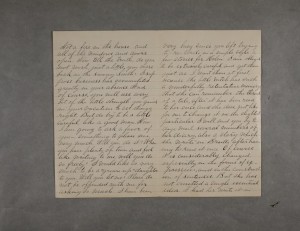For the first time ever, the extensive 1880s-era correspondence between Helen Keller, her teacher Anne Sullivan and Sullivan’s mentor at Perkins School for the Blind, Michael Anagnos, are available online. An unusual collaboration between the American Antiquarian Society and Perkins (www.perkinsarchives.org) harnesses the power of social media to create a revealing new online exhibit that unites previously separate collections in a single online showcase:www.flickr.com/photos/perkinsarchive/collections/72157629303816171. The announcement is timely, since October is both World Blindness Awareness Month and American Archives Month.

The story of how Anne Sullivan unlocked Helen Keller’s brilliant intellect is well documented in literature, such as William Gibson’s Tony and Oscar winning work, The Miracle Worker. Yet these letters provide even deeper and more detailed insights to historians, writers, educators and all who are fascinated by Keller, one of the most admired and beloved figures of the 20th century. The digital archives allow viewing anytime from anywhere without handling the primary documents, thus preserving the fragile and valuable letters. The digital scans are clear and vivid, and the online collections also give researchers transcribed text. Betsy McGinnity, director of Perkins Training and Educational Resources Program, says, “Combining the AAS and Perkins archives helps put each individual letter in context. And the transcriptions can be accessed using computer screen readers – a real boon for users who are visually impaired.”
Thanks to a National Endowment for the Humanities grant, Perkins will digitize selected 19thcentury materials in its archives, such as the 1886-1895 correspondence between Perkins second director, Michael Anagnos, and Helen Keller’s parents, as well as a series of missives between Anagnos and Sullivan, all of which illuminate Keller’s early education. Also included in this collection are some of the earliest letters written by Helen Keller herself, when she was between the ages of 8 and 11 years old. Her letters to Anagnos show the great bond of affection between the two. Written in Helen’s own hand, these astonishing letters display the child’s exceptional intelligence. One is even written in French. They demonstrate her playful sense of humor, as well as her curious and eager mind.

Sullivan’s letters to Anagnos outline her challenges, her triumphs, and her joy at Helen’s rapid progress. In her first letter written March 13, 1887, less than two weeks after the novice tutor arrived at the Kellers’ Alabama home, Sullivan writes of the child, “I find considerable trouble in controlling her.” Not long after that, however, she bursts with enthusiasm, writing, “Never did a teacher have more reason to be proud of a pupil. A sweeter or brighter child it would be impossible to find…”The evidence of wisdom gained by human struggle in the collected correspondence is both instructive and inspirational. Later in life, Keller wrote, “Usefulness, I believe, is the highest joy…” How fitting that others can now use and learn from these documents from her childhood.
By joining forces to create this online archive, AAS and Perkins achieve many shared goals, proving the adage that the whole is greater than the sum of its parts. As David McCullough says in an AAS video, “One of the lessons of history is that very little of consequence is accomplished alone.”
To learn more about Perkins visit their website at www.Perkins.org.
